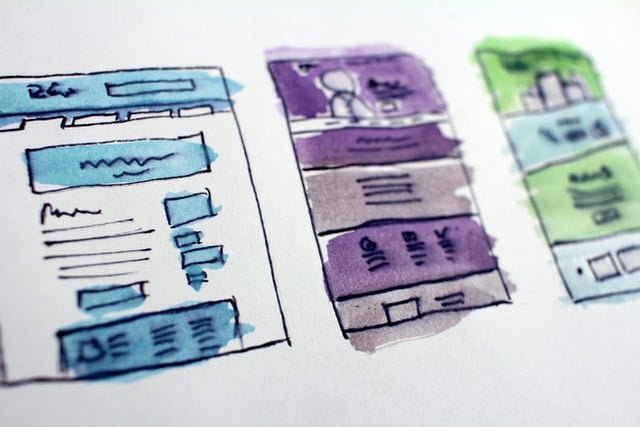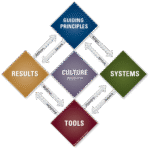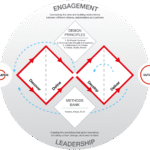
Design Thinking, also known as “Pensamiento de Diseño” in Spanish, is the most popular innovation methodology. It is a dynamic, human-centered approach designed to solve complex problems through creativity, collaboration, and innovation. This tool helps entrepreneurs design innovative products and services as it enables the identification of customer needs (problems).
The popularity of the Design Thinking (DT) methodology lies in its creative problem-solving process, aimed at identifying innovative solutions in a short time to address user needs.
Applying Design Thinking techniques to company problems can help managers across industries rethink their product offerings, expand market growth, deliver greater value to customers, innovate, and stay relevant (Linke, 2017).
However, it is essential to note that design is more than creating products and services—it can be applied to systems, procedures, protocols, and customer experiences (Naiman, 2019). In this sense, the scope of Design Thinking is quite broad. In this article, we aim to provide information about the definition, uses, principles, and some examples of the Design Thinking methodology.
What is Design Thinking?
Design Thinking (DT) is defined by Friis and Yu (2021) as “an iterative process in which we seek to understand the user, challenge assumptions, and redefine problems in an attempt to identify alternative strategies and solutions…”
IDEO, on the other hand, defines Design Thinking as “a human-centered approach to innovation, anchored in understanding customer needs, rapid prototyping, and generating creative ideas that will transform how you develop products, services, processes, and organizations.” Notably, IDEO played a crucial role in popularizing Design Thinking as an innovation management approach (Auernhammer y Roth, 2021).
DT focuses on developing a deep understanding of the user. However, it should not be confused with “Customer-Centered Design.”
Design Thinking helps us in the process of questioning: questioning the problem, questioning assumptions, and questioning implications. That’s why it is often referred to as “thinking outside the box.” This methodology integrates user empathy, ideation, prototyping, and testing to create solutions that meet user needs and expectations.
Finally, Cross (2023) concludes that there are two distinct versions of “Design Thinking” in scientific literature that need to be differentiated. According to the researcher, these two versions have caused confusion because they share the same term but have different approaches and applications:
- DesignThinking 1 refers to the original formulation of “DT,” based on design practice, reasoning, cognition, and processes. It relates to the academic study of design and is also known as “designerly thinking.” This version focuses on how designers think and work.
- DesignThinking 2 is a more recent and popular formulation applied in business and other areas outside traditional design. This version often simplifies design processes and is used by consultants who may lack design expertise.
Why is Design Thinking Important?
DT is important for various reasons, benefiting individuals and organizations alike. Its value has been demonstrated across diverse fields. At its core, Design Thinking is a human-centered problem-solving approach aimed at finding innovative solutions to complex challenges.
Dell’Era et al., (2025) reported six sets of Design Thinking practices: discovering user needs, understanding the problem, challenging existing assumptions, navigating the problem-solution pair, ideating through visualizations, and learning through prototyping. Below, we outline different applications that highlight the importance of Design Thinking:
- Fosters innovation and creativity: DT encourages people to think differently, challenge assumptions, and explore new ideas. By moving beyond traditional methods, it enables novel and original solutions.
- Human-centered focus: Design Thinking places people—users—at the center of the design process. It seeks to deeply understand their needs, desires, and motivations through research and empathy, ensuring solutions are relevant and address real user needs. In this regard, Swasty et al., (2025) highlight that design thinking is an essential component of user experience (UX) design.
- Addresses complex, poorly defined problems: It is particularly useful for tackling “wicked problems,” characterized by multiple unknown factors and no definitive solution. Its iterative and flexible process adapts to complexity, identifying suitable solutions.
- Non-linear, iterative process: Unlike linear approaches, DT is dynamic, allowing stages to overlap, repeat, or even revert. This flexibility promotes learning from mistakes, refining ideas, and achieving more effective solutions.
- Applicable across industries and contexts: Design Thinking isn’t limited to product design but can be applied to any problem requiring a creative solution, including business, education, government, nonprofits, and daily life.
- Promotes collaboration: It fosters teamwork among individuals from diverse disciplines, enriching the process with varied perspectives to generate more comprehensive and innovative solutions.
- Supports business model innovation: You (2022) emphasizes DT as a mindset with principles that improve design processes, such as reflective practice, visualization, and empathy. It is valuable for business model innovation, encompassing design reasoning, problem-solving, learning approaches, and decision-making essentials.
- Reduces risk and costs: By testing ideas through prototypes, Design Thinking identifies errors early, preventing significant time and financial investments in final solutions. This reduces the risk of launching ineffective products or services.
- Balances desirability, feasibility, and viability: DT integrates user needs (desirability), technical feasibility, and business viability to ensure solutions are useful, realistic, and sustainable.
- Enhances customer experience: By focusing on user needs, it helps create products and services that deliver a better experience, increasing satisfaction, loyalty, and retention.
- Facilitates continuous learning: Design Thinking fosters a cycle of experimentation, feedback, and improvement, enabling organizations and individuals to learn and grow continuously.
What Is Design Thinking Used For?
The design process for a product or service involves the participation of different groups of people across various departments. In this context, Dam y Yu (2021 point out that developing, categorizing, and organizing ideas and solutions to problems can be challenging, and the DT approach is one way to keep the entire organization aligned.
The structure of Design Thinking creates a natural flow from research to launch. Immersion in the customer experience generates data, which is transformed into insights that help teams agree on the design criteria used to generate solutions (Liedtka, 2018).
Similarly, Neiman (2019) emphasizes that DT minimizes uncertainty and the risks associated with innovation by involving customers or users through a series of prototypes to learn, test, and refine concepts.
Design Thinking can be applied across any sector and is used to:
- Solve problems creatively and innovatively
- Understand unmet user needs
- Design and develop products or services
- Redesign business processes
- Launch and grow enterprises
Mayer y Schwemmle (2024) highlight that Design Thinking has four levels of impact:
- Individuals:
Design Thinking influences individual psychological benefits (e.g., creative confidence and self-efficacy), individual capabilities and skills (e.g., 21st-century skills and creativity), and individual academic performance. - Teams:
It impacts team innovation, team performance, psychological benefits for teams, and collaborative benefits. - Organizations:
DT affects organizational innovation, performance, culture, and capabilities. This level of impact is the most studied. - Society:
It drives social innovation, social engagement, and educational benefits at a societal level.
Principles of Design Thinking
According to Christoph Meinel and Harry Leifer of the Hasso-Plattner-Institute of Design at Stanford University, California, Design Thinking is founded on four principles:
- The Human Rule:
Design activities must be human-centered, and innovations created through the Design Thinking process should prioritize the human aspect. - The Ambiguity Rule:
Ambiguity is inevitable and must be embraced during the Design Thinking process. Individuals should strive to experiment and test new ways of approaching problems. - The Re-Design Rule:
Although social situations, circumstances, and technologies may evolve, basic human needs remain constant. This means all designs (or problem solutions) are essentially re-creations based on previous approaches to meeting these needs. - The Tangibility Rule:
Prototypes should be used to produce tangible ideas that can be effectively communicated.
Design Thinking Methodology
In the current literature, you will find many variations of the Design Thinking process, ranging from three to seven phases, states, or steps. However, despite these variations, the process remains quite similar. For instance, Rösch et al., (2023) describe the process in three stages: gathering data about the problem, generating ideas, and testing.
Below, we outline the five-step Design Thinking methodology proposed by Stanford, which is the most widely accepted. It is important to note that these steps are not always sequential:
Empathize
The first phase aims to deeply understand the needs, desires, and motivations of users. This involves setting aside personal assumptions and immersing yourself in the user’s world to gather firsthand insights. Techniques for empathizing include:
- User research: Conduct interviews, surveys, and focus groups to gather information about users’ experiences and perspectives.
- Observation: Observe users in their natural environment to understand how they interact with products or services.
- Immersion: Engage in the user’s physical environment to gain deeper insights into their challenges and experiences.
- Empathy maps: Visualize users’ emotions, thoughts, and behaviors.
Example: A team looking to improve the shopping experience in a supermarket might interview customers, observe their in-store journeys, and analyze complaints and suggestions.
Define
In this stage, the information gathered during the Empathize phase is analyzed to clearly define the problem to be solved. The goal is to craft a user-centered problem statement that is clear, concise, and actionable. Key aspects include:
- Data analysis: Identify patterns, recurring themes, and key insights from user research.
- Problem statement: Write a clear description of the problem to be solved, focusing on user needs.
- “How might we” questions: Frame the problem as a question to encourage creative idea generation.
Example: After analyzing supermarket interviews, the team defines the problem as: “Customers need a more efficient way to find the products they’re looking for and avoid long checkout lines.”
Ideate
Ideation involves generating a wide range of possible solutions to the defined problem. The goal is to foster creativity and explore innovative ideas. During this stage, it’s crucial to avoid judgment or criticism. Techniques include:
- Brainstorming: Generate ideas freely and spontaneously in a group setting.
- Mind mapping: Visually organize ideas to explore connections and patterns.
- Bodystorming: Act out and physically represent scenarios to spark new ideas.
- Provocation: Challenge established beliefs to discover alternative solutions.
Example: The supermarket team conducts a brainstorming session to generate ideas for improving the customer experience, ranging from an app to locate products to a self-checkout system integrated into shopping carts.
Prototype
The most promising ideas are turned into tangible prototypes to experiment, test, and refine solutions. Prototypes can be quick, low-fidelity versions that allow for agile feedback collection. Examples of prototypes include:
- Paper models: Simple representations of a product or service interface.
- Mock-ups: Low-fidelity physical versions of a product.
- Storyboards: Visual representations of usage scenarios.
- Functional prototypes: Basic but functional versions of a product or service.
Example: The supermarket team creates prototypes for an app to locate products, an in-store navigation system, and a self-checkout system using paper models and mock-ups.
Test
This is the final stage, where prototypes are tested with real users to gather feedback and validate solutions. Test results may lead to refining prototypes, iterating on ideas, or even revisiting earlier stages to redefine the problem. Key aspects include:
- User testing: Observe users interacting with prototypes and collect their feedback.
- Data analysis: Evaluate test results to identify areas for improvement and potential issues.
- Iteration: Modify prototypes and retest to refine solutions.
Example: The supermarket team tests prototypes with real customers, observing how they interact with them and collecting feedback to identify areas for improvement.
Design Thinking Toolkit
As a toolkit, Design Thinking refers to the application of numerous methods and techniques from various disciplines: design, as well as engineering, computer science, and psychology (Brenner et al., 2016).
Castillo et al (2014) recommend a series of tools for the different steps of the Design Thinking process, as summarized in the following table:
Table 01. Design thinking tools (Toolkit).
| Steps in the Design Thinking Process | Tools |
| Empathize | – Interviews – Focus Groups – Shadowing – Persona Profiles – Customer Segment Profiles – Empathy Map – Storyboards – Customer Journey Map |
| Define | – Problem Tree – Value Curves – Context Map |
| Ideate | – Brainstorming – Cardsorting – Offering Map |
| Prototype | – Prototype – Mockup – Business Model |
| Validate or Test | – Pinocchio Product – The Speedboat – Prototype Testing – Usability Testing of Beta in Real Environment |
Profile of a Design Thinker
As important as understanding the design thinking process is recognizing the team that must lead it. In this regard, Brown (2008) emphasizes that a design thinker should have the following characteristics:
- Empathy: They are capable of imagining the world from multiple perspectives.
- Integrative Thinking: They not only rely on analytical processes but also demonstrate the ability to see all the prominent and sometimes contradictory aspects of a problem and create innovative solutions.
- Optimism: Regardless of how challenging a problem’s limitations may be, there is always at least one solution that is better than the existing alternatives.
- Experimentation: Design thinkers pose questions and explore constraints in creative ways, leading to entirely new directions.
- Collaboration: The best design thinkers not only work alongside other disciplines but often have extensive experience in more than one discipline.
Examples of Design Thinking
Some of the world’s leading companies, such as Apple, Google, Samsung, and GE, have quickly adopted the Design Thinking approach.
Today, DT processes are being applied in fields beyond business, such as education, healthcare, and public policy development. Below are examples of studies highlighting the use of Design Thinking:
Education
In 2010, Innova Schools launched five secondary schools under the Innova brand but realized that their existing educational model could not scale. To support its growth, Innova Schools worked with IDEO to develop curricula, teaching strategies, infrastructure, operational plans, and the underlying financial model for managing the school network.
Additionally, Li et al (2019) highlight the potential of employing DT to develop students’ learning and design thinking skills through design activities in STEM (science, technology, engineering, and mathematics) education.
Healthcare
Roberts et al (2016) demonstrate how Design Thinking can foster new approaches to complex and persistent health problems through human-centered research, collective and diverse teamwork, and rapid prototyping. They also present the core elements of Design Thinking for healthcare.
Altman et al (2018) published a scientific review on the application of Design Thinking in healthcare, reporting on 24 studies (covering physical health, mental health, and processes). Of these, 12 were successful, 11 reported mixed results, and one was unsuccessful. They conclude that Design Thinking can result in acceptable and effective interventions, though methodological and quality limitations exist.
Similarly, Leow et al., (2023) described the use of “Photovoice” within design thinking to empathize with patient challenges and co-create ideas for managing asthma in Singapore.
Public Policy Development
Mintrom y Luetjens (2016) emphasize that design thinking has the potential to improve problem definition and the design of mechanisms in public policy formulation processes.
What Are the Main Limitations of Design Thinking?
Despite being a popular approach to problem-solving and innovation, DT has several limitations. These have been pointed out by various critics and scholars and can be categorized into the following areas:
Limited applicability:
Design Thinking may not be suitable for addressing complex systemic problems because its methods and worldview might not be sufficiently inclusive or robust. It has been argued that its origins in a design paradigm focused on “creation” restrict its scope. Although efforts have been made to extend its use beyond traditional design fields, such as into business, its practices remain rooted in that paradigm.
Narrow interpretation of design skills:
Some applications of Design Thinking, particularly in the business realm, have been criticized for promoting a limited interpretation of design skills. Design consultants have been accused of undervaluing the specific expertise of each discipline, offering “creative confidence” without the real capabilities needed.
Lack of a solid theoretical foundation:
It has been noted that Design Thinking lacks a robust theoretical foundation, which hinders its critical evaluation and advancement as an innovation practice. This absence of theory is problematic because its practice may overlook essential qualities of design necessary for innovation.
Oversimplification of the process:
Design Thinking is often presented as a linear and straightforward process, which oversimplifies reality. In practice, the process may not be linear, with phases overlapping or repeating.
Criticism of the notion of empathy:
The concept of empathy, as used in some formulations of Design Thinking, has been criticized for ignoring how identity and power influence empathetic identification. It has been argued that this perspective may reinforce the privileged role of the designer at the expense of the communities they aim to serve.
Risk of elevating designers to “Spiritual” figures:
There is a noted risk that a radical expansion of Design Thinking could elevate designers to “spiritual” figures whose empathetic skills might overshadow the specific contextual expertise required in professional fields.
Not a universal solution:
It is emphasized that Design Thinking is not a universal solution for all problems and cannot be adequately taught through a brief workshop or seminar.
Design Thinking vs. Lean Startup
Both Design Thinking and Lean Startup aim to iteratively learn to reduce uncertainty and project risk. They also share the same user-centered focus (Camps, 2014).
Mueller y Thoring (2012) highlight that while there are significant differences between Design Thinking and Lean Startup, there are also several similarities in their methodologies and design processes.
Table 2. Differences between Design Thinking and Lean Startup.
| Area | Design Thinking | Lean Startup |
|---|---|---|
| Outcome | Prototype | Minimum Viable Product |
| Process Start Point | Challenge (problem) | Idea to be validated |
| Market Research | Analyzes users using sophisticated techniques | Uses less elaborate qualitative methods |
| Synthesis | Employs advanced methods to synthesize information | |
| Ideation | Uses creativity techniques to generate new ideas | Does not apply creativity techniques |
| Quantitative Evaluation | Places greater emphasis on qualitative evaluation | Uses quantitative metrics |
| Business Model | Does not always refer to the business model | Utilizes the concept of a business model |
Source: Mueller and Thoring (2012).
Various researchers recommend that it is possible to combine Design Thinking and Lean Startup, as they are used at different stages of the business and product creation process.
Initially, Design Thinking can be employed to empathize, define, and ideate. Once ideas are formed, Lean Startup can be used to turn those ideas into business models.
Design Thinking vs Human-Centered Design
Design Thinking and Human-Centered Design (HCD) are related but not identical approaches. Both focus on the user but have significant differences in their scope and application.
Table 3. Differences and similarities between Design Thinking and Human-Centered Design.
| Aspect | Design Thinking | Human-Centered Design (HCD) | Similarities |
|---|---|---|---|
| Origin and Approach | Broad approach to problem-solving, integrating human needs, technology, and business success. | Formal discipline derived from user-centered design, focused on creating usable and useful products. | Both prioritize the user experience and needs as the central axis of their process. |
| Scope | Broad and strategic: applies to business, education, NGOs, products, services, and strategies. | Narrow approach: focused on the creation and improvement of products. | Both use an iterative process to develop effective solutions. |
| Process | Iterative and non-linear with five phases: empathize, define, ideate, prototype, and test. | Specific process used by designers and usability experts. | They value empathy to develop solutions that respond to real people’s needs. |
| Participation | Interdisciplinary collaboration for innovative solutions. | Done by designers and usability experts. | They promote collaboration and teamwork. |
| Methodology | An ideology and process for solving complex problems, not limited to product design. | Structured process focused on usability, accessibility, and human factors. | |
| Application | Complex problems, strategy, product, service, and process design. | Product design with emphasis on usability, accessibility, and user experience. | |
| Objective | Solve problems and create innovative solutions with a human-centered focus. | Design solutions ensuring usability, accessibility, and user satisfaction. |
Design Thinking vs Systemic Thinking
Design thinking and systems thinking are two complementary human-centered approaches to systems analysis and problem-solving that are extremely important in today’s increasingly complex information environment (Ding et al., 2025). While both can be used to address complex problems, they have different approaches. The former is ideal for people-centered innovation, while the latter is crucial for understanding and transforming complex systems. When used together, they can provide more comprehensive and effective solutions.
Table 4. Comparison between Design Thinking vs Systemic Thinking.
| Aspect | Design Thinking | Systems Thinking | Similarities |
|---|---|---|---|
| Main Focus | Human-centered methodology for solving problems in a creative and innovative way. | Discipline focused on understanding the interconnection of elements within a system. | Both address complex and uncertain problems. |
| Methodology | Iterative and non-linear, with stages such as empathize, define, ideate, prototype, and test. | Analysis of relationships and patterns within a system, with emphasis on feedback and causality. | Both promote iteration and adaptation during the problem-solving process. |
| Scope | Specific: development of products, services, strategies, and business models. | Broad: applies to medical, environmental, political, economic systems, and more. | Both seek effective and sustainable solutions. |
| Objective | To create innovative solutions focused on the needs, viability, and feasibility for users. | To understand the structures and behaviors of systems to generate long-term sustainable solutions. | |
| Perspective | User-centered, based on empathy and a deep understanding of needs and motivations. | Holistic, observing the big picture and interactions between parts of the system. | |
| Emphasis | On human needs and solving specific problems. | On the behavior of complete systems and the root causes of problems. | |
| Application | Ideal for designing user-centered products and services. | Suitable for solving complex problems that require systemic change. | |
| Relationship | Can incorporate a systemic perspective to understand how problems and solutions integrate into broader systems. | Can use DT methods like empathy to improve understanding of systems. |
Conclusions
Design Thinking is a tool that facilitates the development of innovative products and services. In this way, entrepreneurs and business owners should develop competencies in this field.
The implementation of a DT process requires individuals who fulfill the profile of a design thinker to facilitate and successfully complete the process, but who also have a clear orientation towards innovation.
On the other hand, Design Thinking can be used with other tools, such as Lean Startup, to achieve better results.
References
Altman, M., Huang, T., & Breland, J. Y. (2018). Design Thinking in Health Care. Preventing chronic disease, 15, E117. https://doi.org/10.5888/pcd15.180128
Auernhammer, J., & Roth, B. (2021). The origin and evolution of Stanford University’s design thinking: From product design to design thinking in innovation management. Journal of Product Innovation Management, 38(6), 623-644. https://doi.org/10.1111/jpim.12594
Brenner, W., Uebernickel, F., Abrell, T. (2016). Design Thinking as Mindset, Process, and Toolbox. In: Brenner, W., Uebernickel, F. (eds) Design Thinking for Innovation. Springer, Cham. https://doi.org/10.1007/978-3-319-26100-3_1
Brown T. 2008. Design Thinking. Harvard Business Review – América Latina. 10 p.
Camps Xavier. 2014. Design Thinking vs Lean Startup. Pulse – Linkedin.
Castillo-Vergara, Mauricio, Alvarez-Marin, Alejandro, & Cabana-Villca, Ricardo. (2014). Design thinking: como guiar a estudiantes, emprendedores y empresarios en su aplicación. Ingeniería Industrial, 35(3), 301-311.
Cross, N. (2023). Design thinking: What just happened?. Design Studies, 86.
Dam Rikkie Friis and Teo Yu Siang. 2021. What is Design Thinking and Why Is It So Popular? Interaction Design Foundation.
Dell’Era, C., Magistretti, S., Candi, M., Bianchi, M., Calabretta, G., Stigliani, I., & Verganti, R. (2025). Design thinking in action: a quantitative study of design thinking practices in innovation projects. Journal of Knowledge Management, 29(11), 32-58.
Ding, W., Lin, X., Zarro, M. (2025). Design Thinking to Systems Thinking. In: Information Architecture and UX Design. Synthesis Lectures on Information Concepts, Retrieval, and Services. Springer, Cham. https://doi.org/10.1007/978-3-031-72138-0_8
García de la Serrana Jorge Irigaray. 2021. Design thinking: qué es y cuales son sus características. EAE Business School.
IDEO. Design Thinking
Leow, M.Q.H., Moosa, A.S., Salim, H. et al. Innovation workshop using design thinking framework and involving stakeholders to co-create ideas for management of asthma. npj Prim. Care Respir. Med. 33, 36 (2023). https://doi.org/10.1038/s41533-023-00357-4
Li, Y., Schoenfeld, A.H., diSessa, A.A. et al. Design and Design Thinking in STEM Education. Journal for STEM Educ Res 2, 93–104 (2019). https://doi.org/10.1007/s41979-019-00020-z
Liedtka J. 2018. Why Design Thinking Works. Harvard Business Review.
Linke R. 2017. Design thinking, explained. MIT Management Sloan School.
Mayer, S., & Schwemmle, M. 2024. The impact of design thinking and its underlying theoretical mechanisms: A review of the literature. Creativity and Innovation Management. https://doi.org/10.1111/caim.12626
Mintrom, M. and Luetjens, J. (2016), Design Thinking in Policymaking Processes: Opportunities and Challenges. Australian Journal of Public Administration, 75: 391-402. https://doi.org/10.1111/1467-8500.12211
Mueller, Roland M., Thoring, Katja. (2012). Design Thinking vs Lean Startup: a comparison of two user-driven innovation strategies.
Naiman, L. 2019. Design Thinking as a Strategy for Innovation. Creativity at Work. The European Business Review. 13 p.
Roberts Jess P., Thomas R. Fisher, Matthew J. Trowbridge, Christine Bent. 2016. A design thinking framework for healthcare management and innovation, Healthcare, Volume 4, Issue 1, 2016, Pages 11-14, ISSN 2213-0764, https://doi.org/10.1016/j.hjdsi.2015.12.002.
Rösch, N., Tiberius, V., & Kraus, S. (2023). Design thinking for innovation: context factors, process, and outcomes. European Journal of Innovation Management, 26(7), 160-176.
Swasty, W., Soedewi, S., & Mustikawan, A. (2025). Design Thinking Approach for Better User Experience: A Systematic Review. KnE Social Sciences, 10(1), 69-75.
Wolniak R. 2017. THE DESIGN THINKING METHOD AND ITS STAGES. SYSTEMY WSPOMAGANIA W INŻYNIERII PRODUKCJI – Inżynieria Systemów Technicznych
You, X. Applying design thinking for business model innovation. J Innov Entrep 11, 59 (2022). https://doi.org/10.1186/s13731-022-00251-2
Editor and founder of “Innovar o Morir” (‘Innovate or Die’). Milthon holds a Master’s degree in Science and Innovation Management from the Polytechnic University of Valencia, with postgraduate diplomas in Business Innovation (UPV) and Market-Oriented Innovation Management (UPCH-Universitat Leipzig). He has practical experience in innovation management, having led the Fisheries Innovation Unit of the National Program for Innovation in Fisheries and Aquaculture (PNIPA) and worked as a consultant on open innovation diagnostics and technology watch. He firmly believes in the power of innovation and creativity as drivers of change and development.





